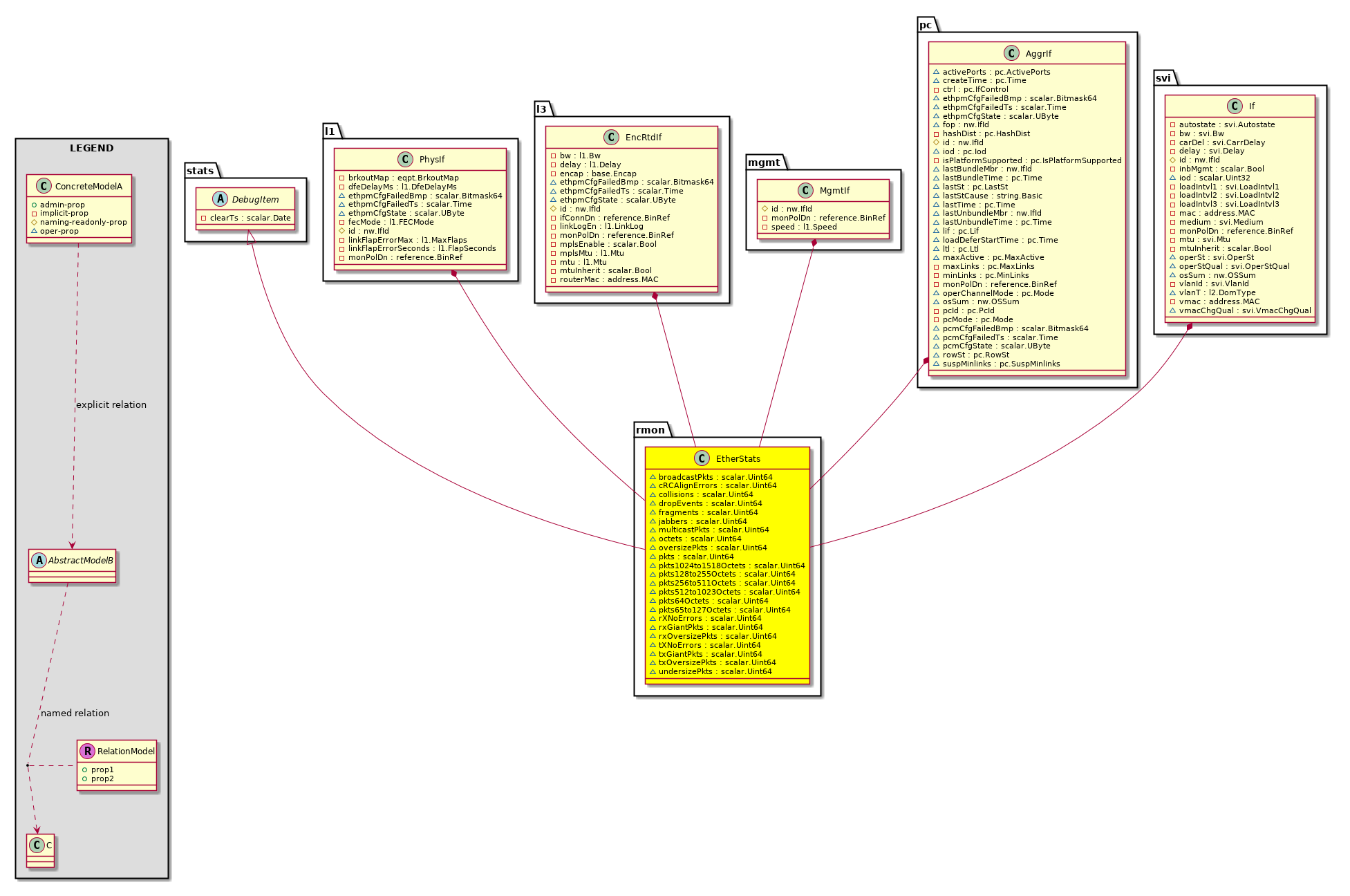| Properties Summary |
broadcastPkts
Type: scalar:Uint64
Units: packets
Encrypted: false
Access: oper
Category: DebugStats
Comments:
-
cRCAlignErrors
Type: scalar:Uint64
Units: packets
Encrypted: false
Access: oper
Category: DebugStats
Comments:
-
The cyclic redundancy check align errors.
childAction
Type: mo:ModificationChildAction
Primitive Type: scalar:Bitmask32
Units: null
Encrypted: false
Access: implicit
Category: TopLevelChildAction
Comments:
-
Delete or ignore. For internal use only.
| |
| Constants |
| deleteAll |
16384u |
deleteAll |
NO COMMENTS
|
| ignore |
4096u |
ignore |
NO COMMENTS
|
| deleteNonPresent |
8192u |
deleteNonPresent |
NO COMMENTS
|
| DEFAULT |
0 |
--- |
This type is used to
|
|
clearTs
Type: scalar:Date
Units: null
Encrypted: false
Access: implicit
Category: TopLevelRegular
Comments:
-
| |
| Constants |
| never |
0ull |
Never |
NO COMMENTS
|
| DEFAULT |
never(0ull) |
Never |
NO COMMENTS
|
|
collisions
Type: scalar:Uint64
Units: packets
Encrypted: false
Access: oper
Category: DebugStats
Comments:
-
The collisions.
dn
Type: reference:BinRef
Units: null
Encrypted: false
Access: implicit
Category: TopLevelDn
Comments:
-
A tag or metadata is a non-hierarchical keyword or term assigned to the fabric module.
dropEvents
Type: scalar:Uint64
Units: packets
Encrypted: false
Access: oper
Category: DebugStats
Comments:
-
The drop event packets.
fragments
Type: scalar:Uint64
Units: packets
Encrypted: false
Access: oper
Category: DebugStats
Comments:
-
The fragmented packets.
jabbers
Type: scalar:Uint64
Units: packets
Encrypted: false
Access: oper
Category: DebugStats
Comments:
-
The jabber frames.
modTs
Type: mo:TStamp
Primitive Type: scalar:Date
Units: null
Encrypted: false
Access: implicit
Category: TopLevelRegular
Comments:
-
The time when this object was last modified.
| |
| Constants |
| never |
0ull |
never |
NO COMMENTS
|
| DEFAULT |
never(0ull) |
never |
NO COMMENTS
|
|
multicastPkts
Type: scalar:Uint64
Units: packets
Encrypted: false
Access: oper
Category: DebugStats
Comments:
-
octets
Type: scalar:Uint64
Units: packets
Encrypted: false
Access: oper
Category: DebugStats
Comments:
-
oversizePkts
Type: scalar:Uint64
Units: packets
Encrypted: false
Access: oper
Category: DebugStats
Comments:
-
The oversize packets.
pkts
Type: scalar:Uint64
Units: packets
Encrypted: false
Access: oper
Category: DebugStats
Comments:
-
The packets.
pkts1024to1518Octets
Type: scalar:Uint64
Units: packets
Encrypted: false
Access: oper
Category: DebugStats
Comments:
-
The packets with 1024 to 1518 octets.
pkts128to255Octets
Type: scalar:Uint64
Units: packets
Encrypted: false
Access: oper
Category: DebugStats
Comments:
-
The packets with 128 to 255 octets.
pkts256to511Octets
Type: scalar:Uint64
Units: packets
Encrypted: false
Access: oper
Category: DebugStats
Comments:
-
The packets with 256 to 511 octets.
pkts512to1023Octets
Type: scalar:Uint64
Units: packets
Encrypted: false
Access: oper
Category: DebugStats
Comments:
-
The packets with 2512 to 1023 octets.
pkts64Octets
Type: scalar:Uint64
Units: packets
Encrypted: false
Access: oper
Category: DebugStats
Comments:
-
The packets with 64 octets.
pkts65to127Octets
Type: scalar:Uint64
Units: packets
Encrypted: false
Access: oper
Category: DebugStats
Comments:
-
The packets with 65 to 127 octets.
rXNoErrors
Type: scalar:Uint64
Units: packets
Encrypted: false
Access: oper
Category: DebugStats
Comments:
-
The received packets with no errors.
rn
Type: reference:BinRN
Units: null
Encrypted: false
Access: implicit
Category: TopLevelRn
Comments:
-
Identifies an object from its siblings within the context of its parent object. The distinguished name contains a sequence of relative names.
rxGiantPkts
Type: scalar:Uint64
Units: packets
Encrypted: false
Access: oper
Category: DebugStats
Comments:
-
RX giant packets
rxOversizePkts
Type: scalar:Uint64
Units: packets
Encrypted: false
Access: oper
Category: DebugStats
Comments:
-
The oversized received packets.
status
Type: mo:ModificationStatus
Primitive Type: scalar:Bitmask32
Units: null
Encrypted: false
Access: implicit
Category: TopLevelStatus
Comments:
-
The upgrade status. This property is for internal use only.
| |
| Constants |
| created |
2u |
created |
In a setter method: specifies that an object should be created.
An error is returned if the object already exists.
In the return value of a setter method: indicates that an object has been created.
|
| modified |
4u |
modified |
In a setter method: specifies that an object should be modified
In the return value of a setter method: indicates that an object has been modified.
|
| deleted |
8u |
deleted |
In a setter method: specifies that an object should be deleted.
In the return value of a setter method: indicates that an object has been deleted.
|
| DEFAULT |
0 |
--- |
This type controls the life cycle of objects passed in the XML API.
When used in a setter method (such as configConfMo), the ModificationStatus
specifies whether an object should be created, modified, deleted or removed.
In the return value of a setter method, the ModificationStatus indicates the actual
operation that was performed. For example, the ModificationStatus is set to "created"
if the object was created. The ModificationStatus is not set if the object was neither
created, modified, deleted or removed.
When invoking a setter method, the ModificationStatus is optional:
If a setter method such as configConfMo is invoked and the ModificationStatus
is not set, the system automatically determines if the object should be created or modified.
|
|
tXNoErrors
Type: scalar:Uint64
Units: packets
Encrypted: false
Access: oper
Category: DebugStats
Comments:
-
The transmitted packets with no errors.
txGiantPkts
Type: scalar:Uint64
Units: packets
Encrypted: false
Access: oper
Category: DebugStats
Comments:
-
TX giant packets
txOversizePkts
Type: scalar:Uint64
Units: packets
Encrypted: false
Access: oper
Category: DebugStats
Comments:
-
The oversized transmitted packets.
undersizePkts
Type: scalar:Uint64
Units: packets
Encrypted: false
Access: oper
Category: DebugStats
Comments:
-
The undersize packets.

